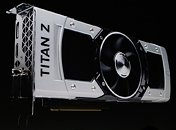Tuesday, March 25th 2014

NVIDIA Announces the GeForce GTX TITAN-Z
Here it is, folks, the fabled monster dual-GPU graphics card from NVIDIA, based on its GK110 silicon, the GeForce GTX TITAN-Z (sounds like "Titans"). The first reference-design graphics card to span across three expansion slots, the GTX TITAN-Z features a cooler design that's an upscale of the GTX 690, with a pair of meaty heat-pipe fed heatsinks being ventilated by a centrally-located fan. The card features a pair of GK110 chips, with all 2,880 CUDA cores enabled, on each. That works out to a total core count of 5,760!
That's not all, the two chips have 480 TMUs, and 96 ROPs between them; and each of the two is wired to 6 GB of memory, totaling a stunning 12 GB on the card. At this point it's not clear if the GPUs feature full-DPFP, but their SPFP totals 8 TFLOP/s. Display outputs on the card include two dual-link DVI, a DisplayPort, and an HDMI. According to its makers, the GTX TITAN-Z is the first graphics card that's truly ready for 5K resolution (5120 x 2700 pixels) on a single display head, for gaming. At US $2,999, the card costs thrice as much as a GTX TITAN Black, for twice its performance.
That's not all, the two chips have 480 TMUs, and 96 ROPs between them; and each of the two is wired to 6 GB of memory, totaling a stunning 12 GB on the card. At this point it's not clear if the GPUs feature full-DPFP, but their SPFP totals 8 TFLOP/s. Display outputs on the card include two dual-link DVI, a DisplayPort, and an HDMI. According to its makers, the GTX TITAN-Z is the first graphics card that's truly ready for 5K resolution (5120 x 2700 pixels) on a single display head, for gaming. At US $2,999, the card costs thrice as much as a GTX TITAN Black, for twice its performance.

122 Comments on NVIDIA Announces the GeForce GTX TITAN-Z
Sounds like a good deal...
oh well, i only needed one kidney anyways ...
* I'm going to guess that the number of people that drop $3K on a graphics card but only have a motherboard with a single PCIe x16 slot borders on the infinitesimal.
Not overclocking a GK110 is a crime. Not overclocking two of them - and you'll be in death row.
The first things I thought when I read it:
Wat.
Whyyyyyyyyyyyy??????
Then I realized the pace of new architectures and performance bumps has been slowing somewhat in the past couple years... it's probably a result of that.
oh, money? ok...
Probably for acoustic reasons, 3slot radiator should take care of the rest.
But the price is just, :yawn:
since titan black has around 5 Gf that means a substantial lower clock and potential good perf/watts
it may still require 3 8pins to power it.
Should be good news for downsampling if they do enable it, 5120x2160 on a 29" 21:9 will be sweet.
GTX 790 = 2304 CC x2 + 850 Core Clocks x2 + 3GB Frame Buffers x2 + Dx11.1 + Premiums is roughly $1,099.99.
GTX Titan-Z = 2880 CC x2 + 800 Core Clocks x2 + 6GBs Frame Buffers x2 + DX11.2 + 1/3(32-bit FPP) for 64bit FPP + Premiums is roughly $2,999.99
Price Difference = factor of 2.72779 more.
CC Difference = 25.0%.
Core Clocks = 6%.
Frame Buffer Size = 2.0
DX11.1 versus DX11.2...
Single Point Precision versus Double...
Side Notes:
1. Basically it's a GTX Titan Black Card x2. Nothing more, nothing less.
2. Unless you're using 3x 4K TV Screens for Surround, you'll probably never utilize the full Frame Buffer amount.
3. This doesn't really cannibalize sales of K40 Tesla because the price you pay for one, mainly, is for the 1x 12GB Frame Buffer to 1 GPU versus 2x 6GB Frame Buffers to 2 GPUs. In addition, all the features you'd find on a workstation graphic card.
4. Card would be more ideal for ZBrush or other animation software that utilizes a lot of subdivisions for a cheaper price in comparison to the Tesla K40.
5. My own personal point of view. A lot of people are saying that NVidia GTX 780 Ti sales are high. People, on a macro level, would pay the extra $100 to 200 dollars for 1 to 10 frames more in PC Games. I disagree that GTX 780 Ti are selling well. Instead, I believe that NVidia is pushing more Dual-GPU Variants to produce more sales because the GTX 780 TI sales are stagnate in comparison to the competition, and the recent price increases that's occurred thanks to the Crypto-Money situation. If sales of GTX 780 TI were high, prices would be going up. Instead they are static. In addition, when a company doesn't push out new tech fast enough, it's because they are still continuing to ride their money cash-cow. There's no point in spending more money when the end-game of the business is to generate more money from the consumers and spend less for cost. Therefore, NVidia is pushing GTX 790 and GTX Titan-Z, as investments, to produce more money from it's consumer bases.
6. I suspect since ROG is only coming out with a dual GPU AMD variant, it's safe to say the "King of the Year" is the AMD ARES III (R9-290x x2, 2x 2816 SP, 4GB Frame Buffers x2, full DX11.2 support, 1000 Mhz Turbo Cores x2). This could change with a MARS IV or V with Titan-Z in the near future... Only issue I see with the King of the Year is the frame time Variance. How it's going to handle on a single Graphic Card.
7. GTX 780 Ti and GTX Titan Black have probably set the bar, as far as FPS performance, for the GTX Titan-Z x2. I don't expect 2x scaling like the 2x R9-290x competition, on an FPS Performance, competition comparison. Furthermore, Titan-Z FPS Performance will probably be less than GTX 780 Ti x2 or GTX Titan Black x2 in SLI.